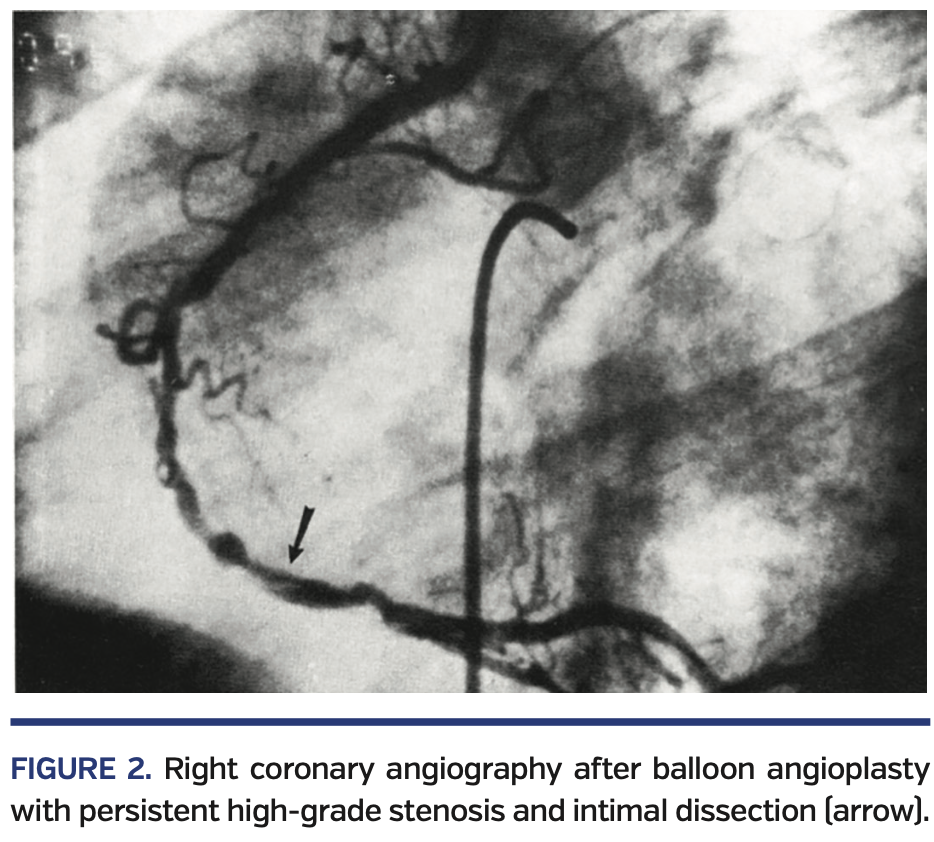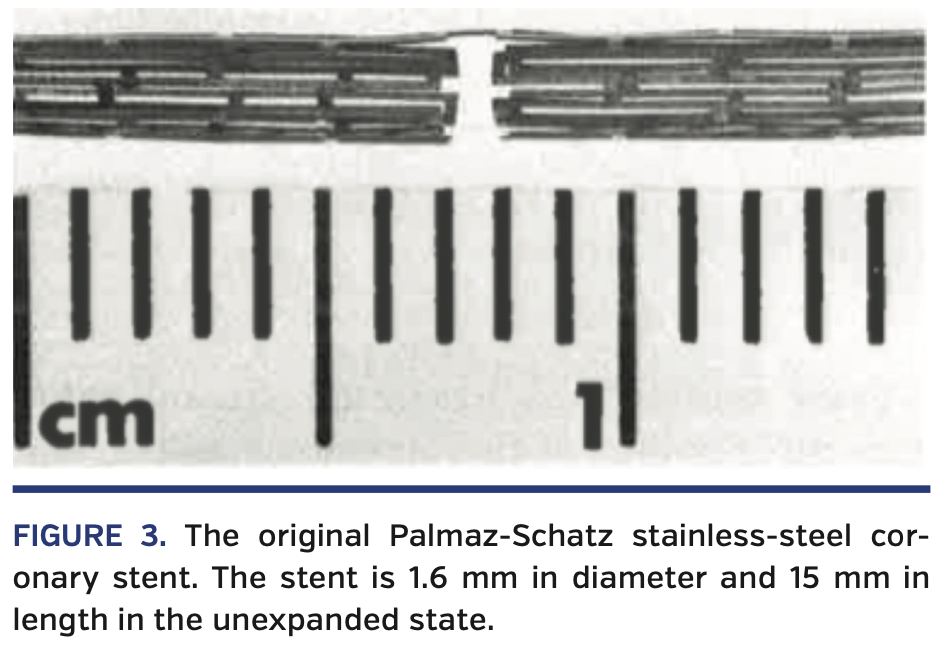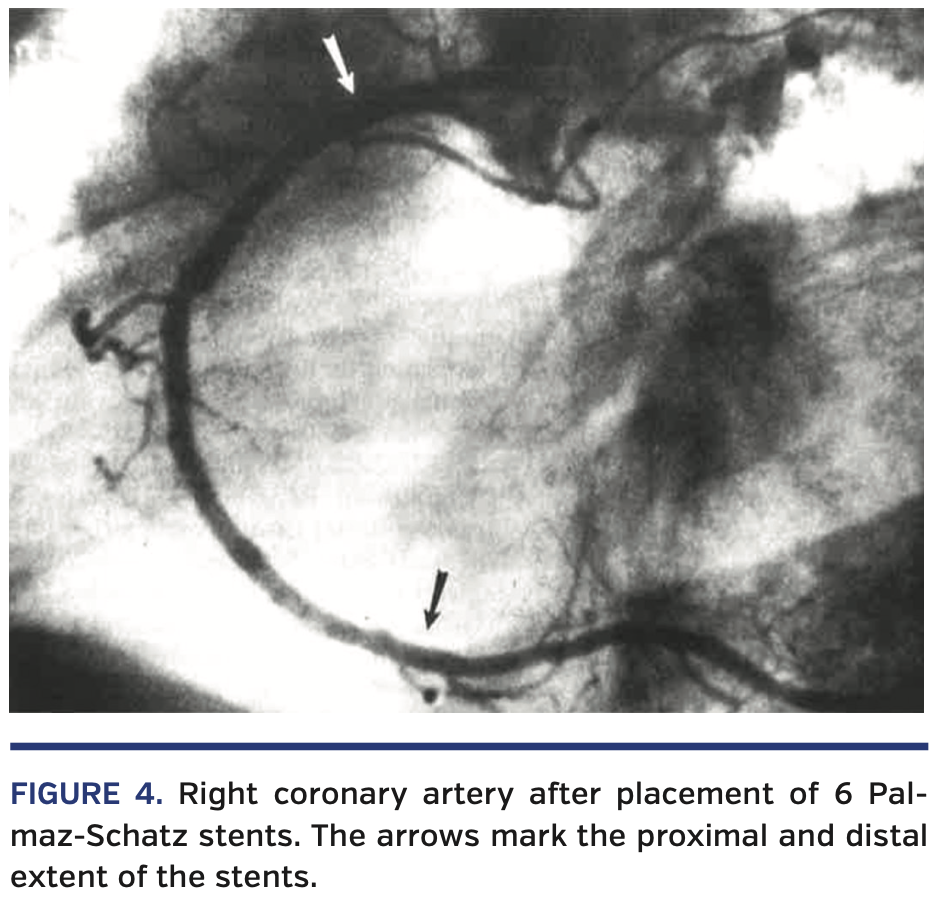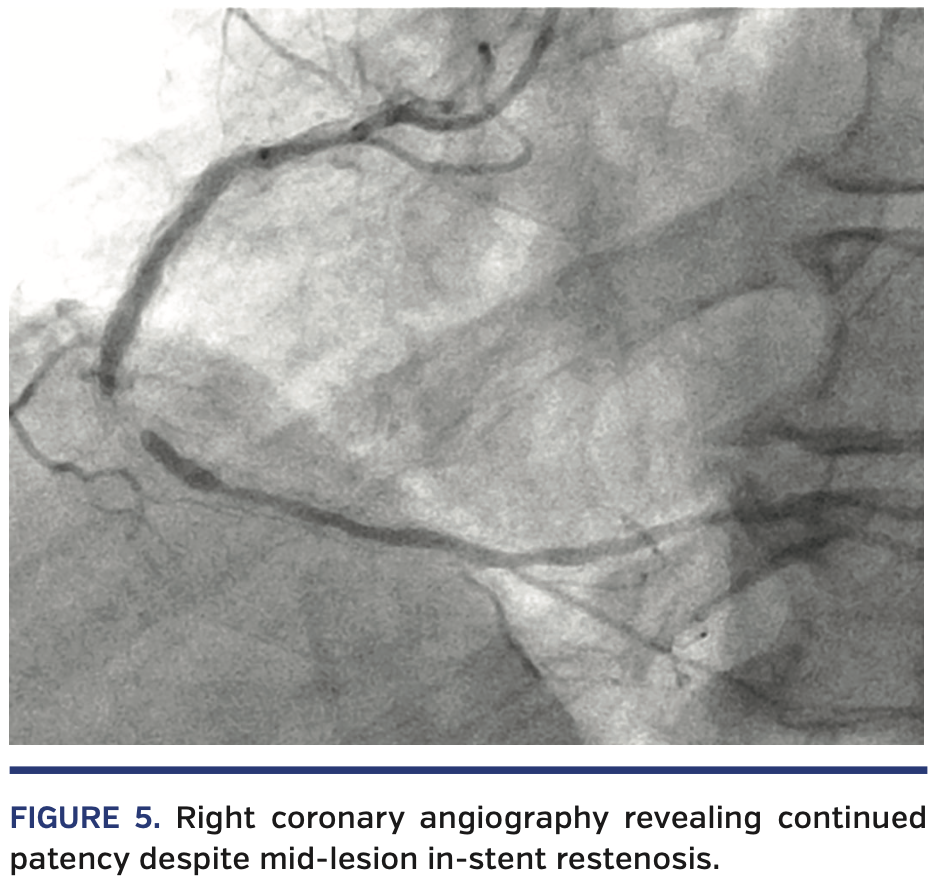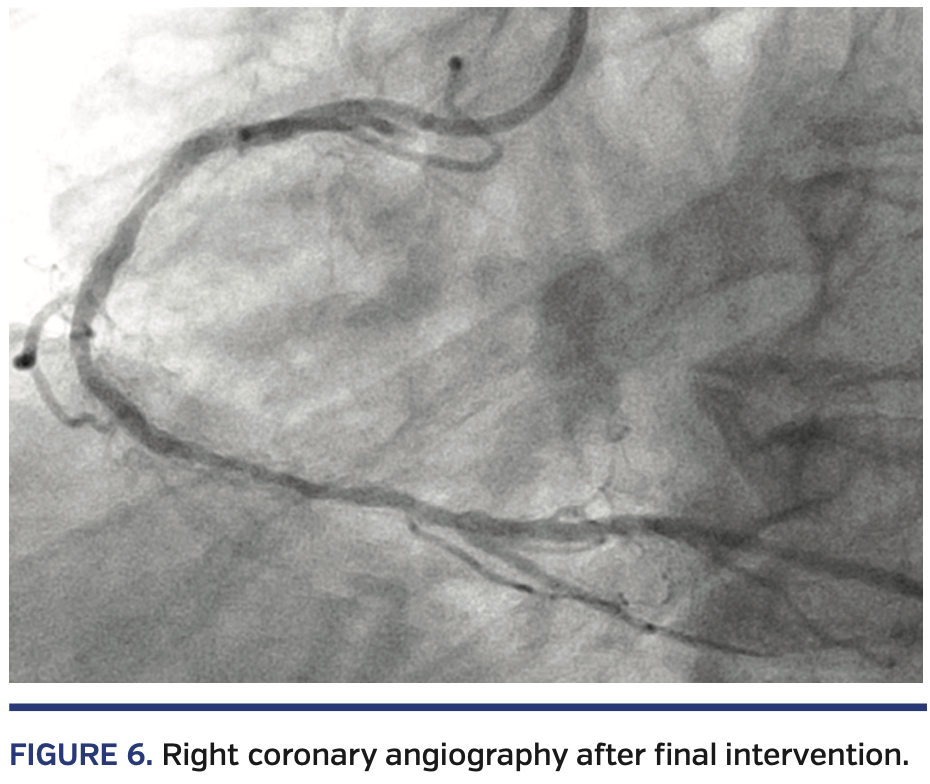The Original Coronary “Full Metal Jacket”: A 30-Year Journey
Abstract: This report provides a 30-year follow-up on a noteworthy case first described by Fischman et al in the September/October 1989 issue of the Journal of Invasive Cardiology. The original article provided the first-known report of extensive intracoronary stenting, deployed in tandem, now colloquially referred to as a “full metal jacket” (FMJ). This case was especially notable at the time of publication for demonstrating that the FMJ stenting technique could provide substantial angiographic improvement following suboptimal result with balloon angioplasty.
Key words: atherosclerosis, coronary stenting, FMJ stenting
As first reported in the September/October 1989 issue of the Journal of Invasive Cardiology,1 a 44-year-old male smoker with a past medical history of dyslipidemia and a family history of premature coronary artery disease presented for evaluation of chest pain following a markedly positive exercise electrocardiography (ECG) stress test. The initial cardiac catheterization revealed multiple high-grade atherosclerotic lesions in the right coronary artery.
Initially, the patient was treated with medical therapy. Despite this therapy, the patient experienced a recurrence of his symptoms 6 months later. A repeat cardiac catheterization was performed, showing a chronic total occlusion of the right coronary artery (RCA), with extensive left to right collateral vessels. Given the severity and diffuse nature of the coronary disease, percutaneous coronary intervention (PCI) was deferred in favor of further medical optimization. However, despite a medication regimen including a beta-blocker, calcium-channel blocker, and nitrates, the patient’s lifestyle continued to be markedly limited by exertional angina.
Ultimately, on February 1, 1989, nine months after the initial cardiac catheterization, the patient underwent PCI of his RCA with consent for the possible use of the Palmaz-Schatz stent (Johnson & Johnson) under an investigational protocol. The cardiac catheterization performed at this time showed recanalization of the RCA, with multiple high-grade lesions throughout its course, beginning proximally and extending distally to the crux of the vessel (Figure 1). Initially, balloon angioplasty was performed, using a 3.0 mm dilation catheter. Despite multiple prolonged inflations, there was minimal improvement in the angiographic appearance of the RCA (Figure 2).
Given the suboptimal response to balloon angioplasty, stenting was performed. A total of six 15 mm Palmaz-Schatz stents (Figure 3) were deployed in tandem fashion in the RCA, starting in the distal vessel, near the posterior descending branch, and extending to the proximal RCA. A total of 90 mm of stents were placed. Significant improvement in RCA luminal diameter was observed as well as improvement in the appearance of the dissection along the acute margin (Figure 4).
Following the procedure, the patient was maintained on a regimen of aspirin 325 mg daily and warfarin (goal prothrombin time of 16-18 seconds). Treadmill ECG stress testing was performed at 1 and 3 months post intervention, and showed no evidence of ischemia. Most notably, the patient remained asymptomatic following this extensive “full metal jacket” (FMJ) stenting procedure. Follow-up coronary angiography was performed at 4 months, and showed diffuse moderate intimal hyperplasia throughout the RCA. At the time of initial publication of this case, the patient had been without symptoms for 6 months.
The patient subsequently did well for more than a decade. In March 2001, a cardiac catheterization performed in the setting of unstable angina revealed a 75% in-stent restenosis (ISR) in the mid RCA and an 80% ISR of the distal RCA, for which placement of 2 bare-metal stents was performed. A repeat cardiac catheterization in October 2003 in the setting of an abnormal stress test revealed a 75% stenosis in the proximal RCA and 75% ISR in the distal RCA. He underwent placement of a drug-eluting stent in the proximal RCA lesion and balloon angioplasty of the distal RCA due to an inability to deliver a stent distally. In April 2004, another cardiac catheterization was performed in the setting of chest pain. This revealed a diffuse distal 90% stenosis. Balloon angioplasty was performed achieving a favorable angiographic result with an unsuccessful attempt at placing a drug-eluting stent.
Following this fourth PCI procedure, the patient again did well for over another decade. More recently, a cardiac catheterization was performed in November of 2017, in the setting of unstable angina. This revealed a 90% ISR of the mid RCA, with mild to moderate diffuse disease in the remainder of the vessel. A successful PCI with drug-eluting stent implantation was performed on this 90% ISR, and required the aid of a GuideLiner (Teleflex) to deliver the stent to the target lesion. Finally, in September 2018, the patient underwent a catheterization for unstable angina. This revealed a 95% ISR in the mid RCA, at the location of the most recently placed drug-eluting stent (Figure 5). The patient underwent balloon angioplasty of this lesion. The remainder of the RCA had moderate diffuse disease, but the vessel was still patent nearly 30 years after the initial FMJ procedure (Figure 6). At clinical follow-up in 2019, the patient was free of angina at his 30th anniversary.
Discussion
The term “full metal jacket,” typically defined in the literature as one continuous segment of intracoronary stenting measuring >60 mm, was first used to describe extensive coronary stenting by Kornowski et al in 1998.2,3 FMJ stenting has commonly been utilized to treat long, diffuse, complex coronary lesions. Although surgical revascularization remains an important strategy in treating diffuse coronary disease, often there are no acceptable distal targets for graft insertion. This, coupled with the continued technological optimization of drug-eluting stents, helps to illustrate how FMJ stenting remains a commonly utilized procedure in clinical practice after its first description in the Journal of Invasive Cardiology. Despite some understandable trepidation regarding the use of FMJ stenting, there is an abundance of data illustrating the efficacy and acceptable long-term clinical outcomes of this technique in treating patients with diffuse coronary disease.
The patient described in this report was treated with a total of 90 mm of Palmaz-Schatz bare-metal stents as part of an investigational study conducted prior to the STRESS randomized trial and 5 years before the United States Food and Drug Administration approval of the Palmaz-Schatz stent.4 To our knowledge, the original publication in 1989 was the first report of coronary stenting for such diffuse disease, a technique coined the FMJ many years later. Accordingly, the clinical follow-up status 30 years after the seminal report is unique. Although the patient has required multiple PCIs in the intervening three decades, remarkably the patient has survived without suffering a myocardial infarction or undergoing coronary artery bypass graft surgery.
With the advent of drug-eluting stents, numerous studies have expanded on the outcomes of the FMJ in both de novo coronary lesions and chronic total occlusions (Table 1). Despite the complexity of diffuse coronary artery disease, these observational studies have demonstrated favorable results with both first- and second-generation drug-eluting stents, with acceptable rates of stent thrombosis and target-vessel revascularization at long-term follow-up (up to 10 years in one study).2,5-8
In addition to serving as a review of the FMJ concept, this case provides a historical perspective of the antithrombotic/antiplatelet therapy of intracoronary stenting. Following the original stenting procedure, the patient was treated with the registry protocol of warfarin for 1 month, dipyridamole for 3 months, and aspirin 325 mg daily, indefinitely. Following his repeat procedures more than a decade later, warfarin was no longer in use; rather, he was treated with full-dose aspirin (325 mg) and varying durations of clopidogrel (3-12 months), including a 12-month course after his 2004 procedure. The aspirin was decreased to 81 mg in 2008 and clopidogrel was restarted. In early 2017, the aspirin was discontinued due to bruising, but the low-dose aspirin was restarted following his procedure later that year. At the time of his last follow-up in 2019, he was taking both aspirin and clopidogrel.
Conclusion
Although FMJ stenting remains a controversial topic in interventional cardiology, there is an abundance of data that support this PCI strategy as a safe and effective option to treat coronary disease in a complex and challenging group of patients. Furthermore, with continued procedural and pharmacological advancements, FMJ stenting may continue to see an increasing utilization. Despite this encouraging prospect, there remains a demand for additional study in this area. In particular, further investigation is needed to determine exactly which patients are likely to benefit most from this unique PCI strategy and to evaluate long-term outcomes, but not necessarily outcomes at 30 years.
From the 1Thomas Jefferson University Hospital, 2Pennsylvania Hospital, Philadelphia, Pennsylvania.
Disclosure: The authors have completed and returned the ICMJE Form for Disclosure of Potential Conflicts of Interest. The authors report no conflicts of interest regarding the content herein.
The authors report that patient consent was provided for publication of the images used herein.
Manuscript submitted February 17, 2020, provisional acceptance given February 24, 2020, final version accepted February 28, 2020.
Address for correspondence: David L. Fischman, MD, 111 S. 11th Street, Suite 6210, Philadelphia, PA 19107. Email: david.fischman@jefferson.edu; Twitter: @fischman_david
- Fischman DL, Savage MP, Welsh DV, Wilson PM, Goldberg S. Tandem stenting in the treatment of diffuse coronary atherosclerotic disease: use of multiple Palmaz-Schatz stents. J Invasive Cardiol 1989;1:264-268.
- Sharp AS, Latib A, Ielasi A, et al. Long-term follow-up on a large cohort of “full-metal jacket” percutaneous coronary intervention procedures. Circ Cardiovasc Interv. 2009;2:416-422.
- Kornowski R, Mehran R, Hong MK, et al. Procedural results and late clinical outcomes after placement of three or more stents in single coronary lesions. Circulation. 1998;97:1355-1361.
- Fischman DL, Leon MD, Baim DS, et al. A randomized comparison of coronary-stent placement and balloon angioplasty in the treatment of coronary artery disease. N Engl J Med. 1994;331:496-501.
- Aoki J, Ong AT, Rodriguez Granillo GA, et al. “Full metal jacket” (stented length ≥64 mm) using drug-eluting stents for de novo coronary artery lesions. Am Heart J. 2005;150:994-999.
- Basavarajaiah S, Naganuma T, Lattib A, et al. Extended follow-up following “full-metal jacket” percutaneous coronary interventions with drug-eluting stents. Cathet Cardiovasc Interv. 2014;84:1042-1050.
- Lee CW, Ahn JM, Lee JY, et al. Long-term (8 year) outcomes and predictors of major adverse cardiac events after full metal jacket drug-eluting stent implantation. Cathet Cardiovasc Interv. 2014;84:361-365.
- Durante A, Foglia Manzillo G, Burzotta F, et al. Long term follow-up of “full metal jacket” of de novo coronary lesions with new generation zotarolimus-eluting stents. Int J Cardiol. 2016;221:1008-1012.






